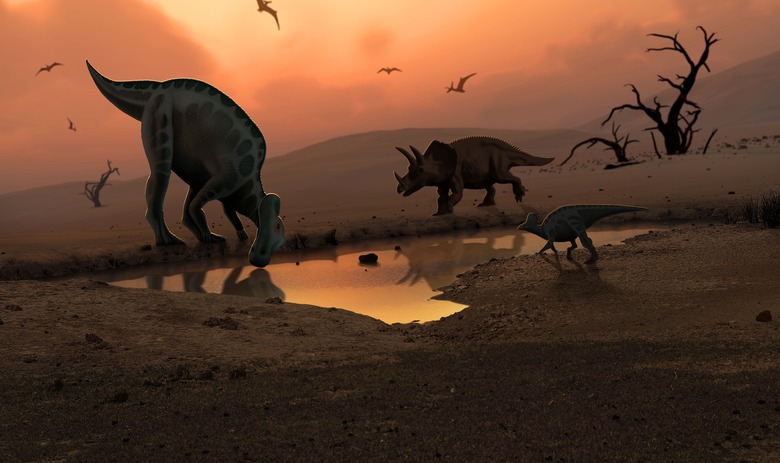Scientists Just Made These 3 Big Prehistoric Discoveries
It might seem like a slow news week for science – after all, there have been no new moon discoveries or record lunar eclipses this week. Instead, scientists have been hard at work solving mysteries from the prehistoric past.
While we know more about dinosaurs and other prehistoric creatures than ever before, there are still plenty of unanswered questions. What did dinosaurs really look like? How did dinosaurs learn to fly? Which other animals lived among them?
These three recent discoveries might not answer everything, they do give us new insight into how dinosaurs lived and help scientists better study the fossils we have. Read on to learn more.
Scientists Uncovered a Desert-Dwelling Pterosaur
First up, scientists have uncovered a accesstoken=KwrclqodWPlBLxuHM572dRgN0jAjWel9jnR3ZoTv0M88M8NaJQ-kBYbpfQ23fyWUVaeO02fn0-4qMtjquEi5JvGnq8JQ48bDx62itGVUeGKAem-y1YU3GAUqRDSjzNKFkSusnUv2xnHrS1eZvGvvJe39j6R9rM9RZLJr8-unfYOV3lRjbnW-gkzd5ACgmJTmObdOUJLqr-eZ99jZploypiIyPO7W3d1j5SQHFB0sTDmb66yAX6i4aNoGBeFRO5WXiYTEj-WMN1kDoYgioxsetvUs-dTrvPLrImY3QZXGk%3D&tracking_referrer=www.smithsonianmag.com'>new fossil of a pterosaur – a flying reptile sometimes called a pterodactyl – in Utah. The findings are big news, since researchers had previously found the remains of just 30 pterosaurs in total.
And this specific finding is huge. Not only does it confirm the existence of larger pterosaurs, but it's also one of the most complete fossils available. Using CAT-scan technology, researchers uncovered large parts of a skull, including a lower jaw.
From the findings, the scientists concluded that pterosaurs could see well, though they probably didn't have a great sense of smell, and had large jaws with plenty of teeth – 112, to be exact. They also confirmed that the pterosaur lived about 65 million years ago, during the Jurassic period.
It's also worth noting: The pterosaur is not a dinosaur. While it's often lumped in with dinos in popular culture – and it did live among the dinosaurs – it comes from a different evolutionary lineage. Birds today are descended from dinosaurs, but not pterosaurs.
Some Dinosaurs Were Even More Colorful Than We Thought
Pop open an old science textbook and you're likely to see dinos illustrated in drab greens, grays and blues. Don't believe it! Not only did many dinosaurs have feathers – instead of the leathery skin you'll find in some old illustrations – but some were brightly colored.
Take Caihong juji, a new "rainbow" dinosaur discovered earlier this year. When researchers found the fossil of this duck-sized dino in China, they also found the vestiges of its colorful plumage, which contained small pigment sacs called melanosomes. The melanosomes signal that the dinosaur's head and throat were iridescent and rainbow-colored, kind of like the plumage you'd see on a hummingbird today.
Since birds originally descended from dinosaurs, finding melanosomes in fossils might give us insight into how the dinos, over millions of years, evolved into the birds we know today.
Lab-Grown Fossils Might Reveal how Dinosaurs Looked
One of the reasons scientists had dinosaurs' appearance so wrong – and why we're just learning more about dinosaurs' color and plumage now – is that fossils don't always tell the whole story.
Scientists may be able to find the bone structure from a fossil, sure, but some fossils don't also retain much evidence of soft tissue, like skin and feathers. Other fossils might have evidence of soft tissue – but without better understanding how fossils form, scientists can't use them to conclude how the dinosaur looked.
New lab-grown fossils might offer a new way for scientists to study dinosaurs. The "fossils" are made by burying a known specimen – like a lizard's foot – in clay, then applying high pressure with hydraulic press and baking the fossil to mimic millions of years of aging. Then the scientists crack open the clay to study the fossil, just like they would do in the field.
Looking at lab-grown fossils helps scientists learn how different types of tissue break down as they fossilize, and find out which finds of tissue might be preserved.
From there, they can compare it to real fossils – to learn more about how dinosaurs looked, how they evolved from each other, and other prehistory mysteries.
Cite This Article
MLA
Tremblay, Sylvie. "Scientists Just Made These 3 Big Prehistoric Discoveries" sciencing.com, https://www.sciencing.com/scientists-just-made-these-3-big-prehistoric-discoveries-13714424/. 15 August 2018.
APA
Tremblay, Sylvie. (2018, August 15). Scientists Just Made These 3 Big Prehistoric Discoveries. sciencing.com. Retrieved from https://www.sciencing.com/scientists-just-made-these-3-big-prehistoric-discoveries-13714424/
Chicago
Tremblay, Sylvie. Scientists Just Made These 3 Big Prehistoric Discoveries last modified March 24, 2022. https://www.sciencing.com/scientists-just-made-these-3-big-prehistoric-discoveries-13714424/
